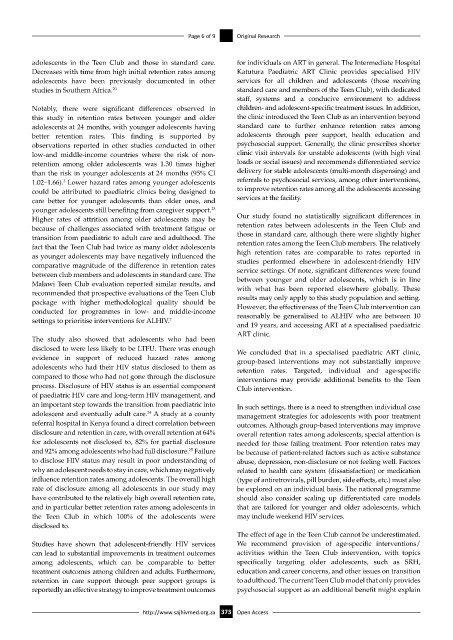Page 381 - HIVMED_v21_i1.indb
P. 381
Page 6 of 9 Original Research
adolescents in the Teen Club and those in standard care. for individuals on ART in general. The Intermediate Hospital
Decreases with time from high initial retention rates among Katutura Paediatric ART Clinic provides specialised HIV
adolescents have been previously documented in other services for all children and adolescents (those receiving
studies in Southern Africa. 20 standard care and members of the Teen Club), with dedicated
staff, systems and a conducive environment to address
Notably, there were significant differences observed in children- and adolescent-specific treatment issues. In addition,
this study in retention rates between younger and older the clinic introduced the Teen Club as an intervention beyond
adolescents at 24 months, with younger adolescents having standard care to further enhance retention rates among
better retention rates. This finding is supported by adolescents through peer support, health education and
observations reported in other studies conducted in other psychosocial support. Generally, the clinic prescribes shorter
low-and middle-income countries where the risk of non- clinic visit intervals for unstable adolescents (with high viral
retention among older adolescents was 1.30 times higher loads or social issues) and recommends differentiated service
than the risk in younger adolescents at 24 months (95% CI delivery for stable adolescents (multi-month dispensing) and
1.02–1.66). Lower hazard rates among younger adolescents referrals to psychosocial services, among other interventions,
3
could be attributed to paediatric clinics being designed to to improve retention rates among all the adolescents accessing
care better for younger adolescents than older ones, and services at the facility.
younger adolescents still benefiting from caregiver support.
23
Higher rates of attrition among older adolescents may be Our study found no statistically significant differences in
because of challenges associated with treatment fatigue or retention rates between adolescents in the Teen Club and
transition from paediatric to adult care and adulthood. The those in standard care, although there were slightly higher
fact that the Teen Club had twice as many older adolescents retention rates among the Teen Club members. The relatively
as younger adolescents may have negatively influenced the high retention rates are comparable to rates reported in
comparative magnitude of the difference in retention rates studies performed elsewhere in adolescent-friendly HIV
between club members and adolescents in standard care. The service settings. Of note, significant differences were found
Malawi Teen Club evaluation reported similar results, and between younger and older adolescents, which is in line
recommended that prospective evaluations of the Teen Club with what has been reported elsewhere globally. These
package with higher methodological quality should be results may only apply to this study population and setting.
However, the effectiveness of the Teen Club intervention can
conducted for programmes in low- and middle-income reasonably be generalised to ALHIV who are between 10
settings to prioritise interventions for ALHIV. 7
and 19 years, and accessing ART at a specialised paediatric
ART clinic.
The study also showed that adolescents who had been
disclosed to were less likely to be LTFU. There was enough We concluded that in a specialised paediatric ART clinic,
evidence in support of reduced hazard rates among group-based interventions may not substantially improve
adolescents who had their HIV status disclosed to them as retention rates. Targeted, individual and age-specific
compared to those who had not gone through the disclosure interventions may provide additional benefits to the Teen
process. Disclosure of HIV status is an essential component Club intervention.
of paediatric HIV care and long-term HIV management, and
an important step towards the transition from paediatric into In such settings, there is a need to strengthen individual case
adolescent and eventually adult care. A study at a county management strategies for adolescents with poor treatment
24
referral hospital in Kenya found a direct correlation between outcomes. Although group-based interventions may improve
disclosure and retention in care, with overall retention at 64% overall retention rates among adolescents, special attention is
for adolescents not disclosed to, 82% for partial disclosure needed for those failing treatment. Poor retention rates may
and 92% among adolescents who had full disclosure. Failure be because of patient-related factors such as active substance
25
to disclose HIV status may result in poor understanding of abuse, depression, non-disclosure or not feeling well. Factors
why an adolescent needs to stay in care, which may negatively related to health care system (dissatisfaction) or medication
influence retention rates among adolescents. The overall high (type of antiretrovirals, pill burden, side effects, etc.) must also
rate of disclosure among all adolescents in our study may be explored on an individual basis. The national programme
have contributed to the relatively high overall retention rate, should also consider scaling up differentiated care models
and in particular better retention rates among adolescents in that are tailored for younger and older adolescents, which
the Teen Club in which 100% of the adolescents were may include weekend HIV services.
disclosed to.
The effect of age in the Teen Club cannot be underestimated.
Studies have shown that adolescent-friendly HIV services We recommend provision of age-specific interventions/
can lead to substantial improvements in treatment outcomes activities within the Teen Club intervention, with topics
among adolescents, which can be comparable to better specifically targeting older adolescents, such as SRH,
treatment outcomes among children and adults. Furthermore, education and career concerns, and other issues on transition
retention in care support through peer support groups is to adulthood. The current Teen Club model that only provides
reportedly an effective strategy to improve treatment outcomes psychosocial support as an additional benefit might explain
http://www.sajhivmed.org.za 373 Open Access

